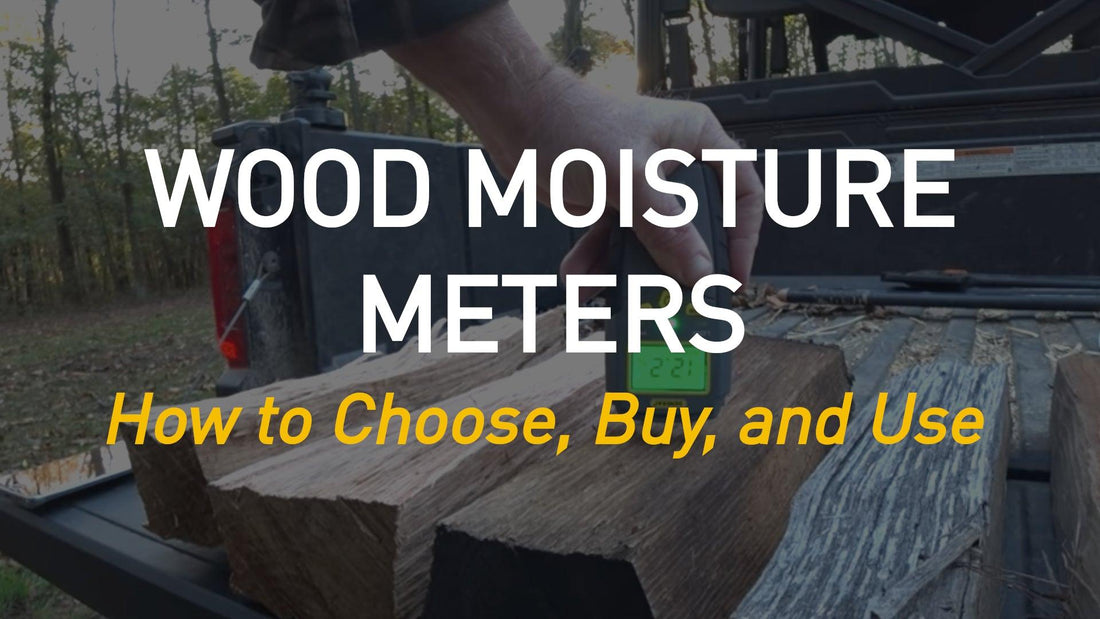
Wood Moisture Meters: How to Choose, Buy, and Use
As any wood fuel expert will tell you, moisture content is the single most important determiner of firewood quality.
When wet wood is burned, it does so very inefficiently. It smoulders and releases a lot of harmful smoke particles (including cancerogenic creosote). But dry the same piece of firewood to a moisture content under 20% moisture and it becomes an incredibly efficient, carbon-neutral, eco-friendly heat source.
Thanks to Defra’s recent Ready to Burn effort, it is now illegal for suppliers to sell poorly dried firewood and briquettes to UK consumers. However, as we’ve informed you in our recent blog post, dry firewood can quickly soak up moisture from the surrounding air if not stored in optimal conditions.
Whether you burn kiln-dried logs or season your own logs, the best way to make sure your firewood is truly ready to burn is by using a moisture meter.
In this article, we will teach you everything you need to know about moisture meters, from whether you actually need them and where they can be purchased to how they function and how to use them properly.
Instructional YouTube Video From Lopi Stoves
Do I Need a Log Moisture Meter?
Before we discuss anything else, let’s figure out whether you personally need a wood moisture meter:
- If you order your firewood or heat logs several times a year and store them indoors, then chances are you don’t need to purchase a wood moisture meter.
- If you buy your wood fuels in bulk and store them for a long time, it is also highly recommended that you get one for moisture control purposes.
- And it does without saying that, you absolutely do need a moisture meter if you season your own logs.
How Does a Log Moisture Meter Work?
The vast majority of commonly available moisture meters are pin-type appliances that work by measuring the electrical resistance of the wood material. The wood moisture meter has two pins, one of which is positively charged and the other negatively charged. In the case of firewood, resistance is directly linked with moisture content, so measuring one gives us ample information to estimate the other.
How to Use a Log Moisture Meter?
Here’s how to use a wood moisture meter for firewood:
- Step 1: Take off the protective cover from your moisture meter to bare the two electrical pins.
- Step 2: Push the meter’s electrical pins firmly into the log.
- Step 3: Press the measure button and wait for the measurement readings to appear.
- Step 4: If the reading is below 20%, then your firewood is safe to use. If it’s over 20%, then it cannot be burned and needs to be seasoned longer.
- Optional: If you want to be absolutely sure that you are not getting a false reading, measure the moisture content of your log in three separate places. Consider the middle of the three values as an accurate representation of the moisture levels.
How to Read a Moisture Meter For Wood?
Here’s how to read a wood moisture meter:
- <9% moisture: Exceptional quality firewood that will burn incredibly cleanly.
- 10%-14% moisture: Superlative quality firewood with great burning qualities.
- 15%-18% moisture: High quality Ready to Burn-compliant firewood.
- 19%-21% moisture: Near the border of Ready to Burn compliance. Additional measurements may be required to ensure compliance.
- 22%-25% moisture: Inadequate quality firewood. Additional seasoning is required to ensure proper performance.
- >25% moisture: Wet wood. Needs to be seasoned. Cannot be burned.
Log Moisture Meter Readings: What Is Normal?
Moisture meter readings of between 12% and 18% indicate dry, safe to burn firewood. Readings below 12% indicate superlative quality firewood. Readings over 20%-25% indicate firewood that is not safe to burn.
Types of Log Moisture Meters
There is a wide selection of log moisture meters on the market. Consumer solutions range in price between £15 and £60, whereas commercial options used by professionals can cost hundreds of pounds. In general, we recommend you avoid wood meters at the very low end of the market as they rarely provide accurate readings. You can expect to pay between £30 and £50 for a high-quality consumer-grade moisture meter from an established brand like Bosch.
What Is a Good Wood Moisture Meter?
We asked our wood fuel experts to come up with a list of the top-rated consumer-grade wood moisture meters at three separate price points. Here are the results:
- Best moisture meter under £25: Stanley 077030
- Best moisture meter under £50: Bosch 603688000
- Best moisture meter over £50: Extech MO210
Where to Buy a Wood Moisture Meter?
Wood moisture meters can be purchased in a wide variety of stores online as well as in hardware stores.
How to Check Moisture Content of Wood Without Meter?
There are several ways of checking the moisture content of your firewood without using a moisture meter:
- Check the ends of your logs for cracks. In general, dry cracks are an indication of dry wood. The more cracks you see, the drier the wood you’re looking at is.
- Hit two logs against each other. Wet wood will give off a dull thud, whereas dry wood will sound hollow (as if it was empty inside).
- Check firewood moisture by burning. Wet wood will smoke, smoulder, and turn the glass of your burner black.

